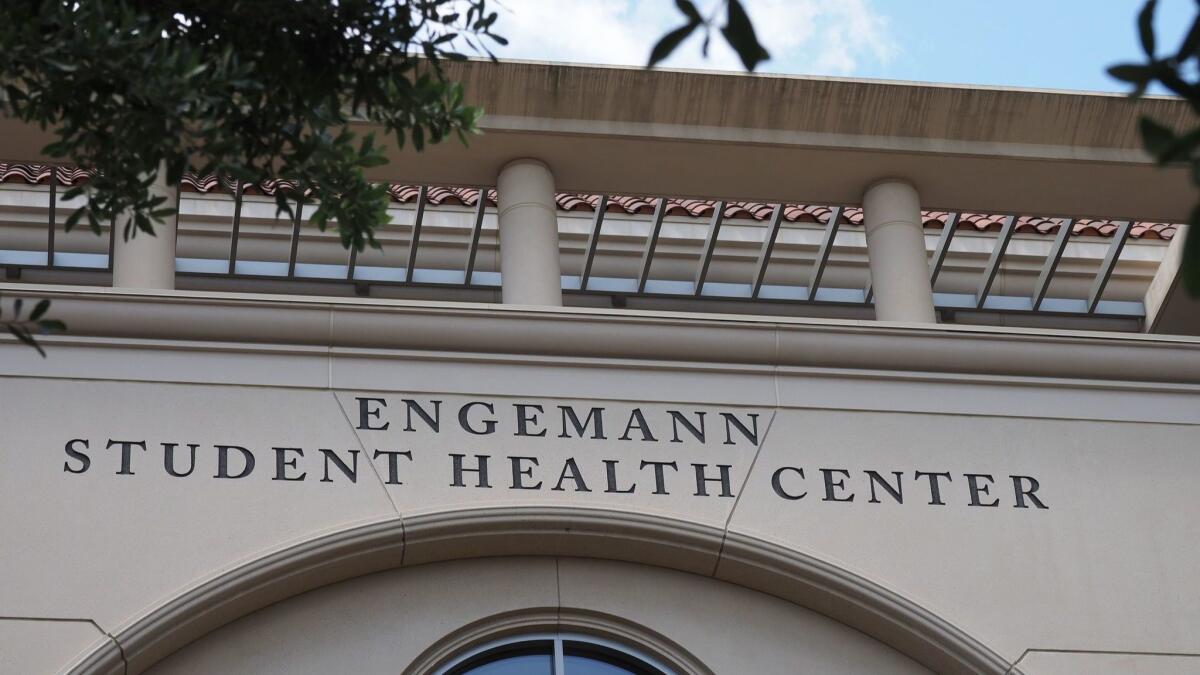USC faces massive litigation over doctor’s alleged sex abuse

- Share via
At least 200 former USC students have joined lawsuits against the university, alleging it failed to heed warnings for nearly 30 years that a campus gynecologist was sexually abusing patients.
Lawyers representing the alleged victims expect the number of women suing to reach at least several hundred and possibly thousands. If successful, the suits could cost the university hundreds of millions of dollars.
“I have never seen anything like the volume of calls we are getting,” said John Manly, a lawyer who has represented sex abuse victims in mass litigation cases.
In the first three weeks following The Times’ revelations, Manly said he received calls from 120 former patients of Dr. George Tyndall, a student health clinic gynecologist who was employed by USC and is now under investigation by the Los Angeles Police Department over allegations of sex abuse.
“The alarming thing is we have women from the very beginning of his employment in 1989 to the very end,” Manly said. “It indicates he engaged in this behavior throughout his tenure at USC.”
Manly was the lead lawyer for sexual abuse victims of Michigan State University sports physician Larry Nassar.
Michigan State settled suits by 332 victims for $500 million, with the average victim receiving $1.3 million, Manly said.
“There were restrictions in the state of Michigan that kept those settlements a little bit depressed, whereas in California I think you are going to see higher numbers,” said David M. Ring, who also has sued USC on behalf of dozens of women.
Suits against the Los Angeles Roman Catholic Archdiocese resulted in a $660-million settlement in 2007, with sex abuse victims receiving an average of $1.5 million each.
Settlements stemming from sexual abuse by an L.A. school district elementary teacher several years ago provided each victim on average more than $1 million, lawyers said.
A class-action suit against Johns Hopkins Hospital over a gynecologist who secretly took pictures and videos of patients led to a smaller, $190-million settlement in 2014. Former patients received $1,876.77 to $27,934.93 in compensation, according to the Baltimore Sun.
The amount of damages awarded in mass litigation generally differs from victim to victim, depending on the severity of the abuse and the harm, lawyers said.
Lawyers for Tyndall’s former patients say he inappropriately put his fingers into their vaginas and anuses, watched them while they undressed, required them to lie naked on the exam table without a sheet, took pictures of their genitals, commented on the size of their vaginas, falsely diagnosed some with dreaded diseases and praised some patients’ breasts.
In interviews with The Times, Tyndall, 71, said he had done nothing wrong. He said his examinations of patients were extremely thorough, but always appropriate.
Campus authorities allowed him to practice until 2016, when a frustrated nurse reported him to the campus rape crisis center.
An internal USC investigation determined that Tyndall’s behavior during pelvic exams was outside the scope of current medical practice and amounted to sexual harassment of students.
Top administrators allowed Tyndall to resign with a payout last summer without informing his patients or reporting him at the time to the Medical Board of California.
Although Tyndall is a named defendant in the litigation, USC is the real target.
“I don’t expect to get a nickel out of the doctor,” Manly said.
About 15 lawsuits have been filed against USC, both in federal court and in Los Angeles County Superior Court. They allege a variety of legal wrongs, falling broadly under the category of negligence and gender discrimination.
Jason Frank, who has represented defendants and plaintiffs in personal injury cases, said the California Supreme Court has limited employer liability only in rare cases.
A hospital would not be liable for an orderly who drugged and raped patients because that behavior would be considered outside the scope of his employment, Frank said.
“It really has to be that extreme in order for a company not to be liable,” said Frank, who is not involved in the USC cases.
Tyndall’s job required him to be with young women when they were undressed and in vulnerable positions, and USC was warned in the past about his conduct — factors that point to liability, Frank said.
Richard S. Linkert, a Sacramento-based lawyer who has defended similar cases for school districts, said employers can be liable for sexual abuse under a theory that they were negligent in retaining and supervising the errant employee.
For the defense, the job may be just about “damage control,” trying to avoid a huge jury award, he said.
“These cases can be so inflammatory and outrageous that it is very easy to get a jury worked up and award giant numbers,” he said. “It is very shocking the large numbers being awarded in Southern California.”
He said USC probably has plenty of insurance to defray the costs.
“I think USC ought to try to settle the cases, the sooner the better,” Linkert said.
In an open letter to faculty and staff in May, USC Provost Michael W. Quick said top administrators had been unaware of the complaints until 2016.
“It is true that our system failed, but it is important that you know that this claim of a cover-up is patently false,” Quick wrote. “We would never knowingly put students in harm’s way.”
USC established a hotline for complaints about Tyndall and has offered free counseling to his former patients.
In investigating the doctor in 2016, USC consulted with a gynecology expert who found that Tyndall’s way of doing pelvic exams could be considered acceptable, USC said, while an outside medical review team found that his pelvic exams conflicted with today’s standard of care.
The university said it also consulted two criminal law experts, who concluded there was no crime to report.
USC blamed the student health clinic’s former executive director, who died two years ago, for “independently” handling complaints about Tyndall. In 2013, the executive director referred some complaints to another department to be investigated. The review concluded no action was needed.
Lawyers say the state lawsuits are likely to be consolidated before one Los Angeles Superior Court judge. In other cases of mass litigation, committees of lawyers have been appointed to represent both sides.
Sometimes, a judge in such cases will pick a handful of cases to go to trial. The jury verdicts then shape the settlement of the others.
Because USC is private, it also could face punitive damages, intended to punish a defendant for wanton and willful misconduct.
USC has retained the law firm of Quinn Emanuel to defend it against the suits and hired O’Melveny & Myers to investigate the allegations and the university’s response.
For the women who are suing, Los Angeles County Superior Court is a considered a favorable venue.
The court has handled such large, complex litigation, and the jury pool is considered friendly to plaintiffs, lawyers said.
The #MeToo movement also has improved the success of such cases, plaintiff lawyers said. Juries are more aware of the harm of sexual assaults, and victims are more willing to come forward, they said.
“The movement has certainly elevated the standing of these sexual assault cases,” Ring said.
Manly, a USC alumnus, said the university may want to resolve the cases quickly to protect its reputation.
“Michigan State treated the victims as adversaries and enemies,” the lawyer said. “In my view, that is a very poor legal strategy. Penn State did not do that in the [Jerry] Sandusky cases. They settled with victims within six months, and in many ways were able to move forward.”
Lawyers defending USC against the suits were unavailable for comment.
“We are committed to concluding these lawsuits quickly,” a USC spokesman said, “and to achieving a fair outcome for those affected by Tyndall’s behavior.”
Times researchers Cary Schneider and Scott Wilson contributed to this report.
Twitter: @mauradolan
More to Read
Sign up for Essential California
The most important California stories and recommendations in your inbox every morning.
You may occasionally receive promotional content from the Los Angeles Times.











